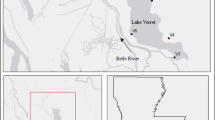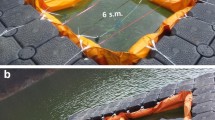Abstract
The present paper deals with the behavior of the Attached Microbial Community (AMC) for water self-purification at different riverbeds in a typical local river. The study quantitatively investigated the problem starting with in-situ sampling. It was found that more biomass of AMC was at riffles with wider distribution than in pools. High current velocity (HCV) plays a negative role at the initial stage of attachment on the riverbed, but HCV aids the community proliferation after stable attachment. External disturbances such as rainfalls and discharges from dams or reservoirs would detach the periphyton depending on the intensity of turbulence in water. However, it was discovered that the flock of periphyton could be restored very quickly because it was not completely removed. Thus, in order to enhance self-purification by periphyton, a suitable configuration of the riverbed must be constructed, and occasional appropriate repair along the channels would improve the decontamination of the river.
Similar content being viewed by others
References
AWWA and WPCF. 1985. Standard Method for the Examination of Water and Wastewater. 19th edition, APHA, Washington DC, USA, 137 pp.
Barica, J., 1990. Seasonal variability on N: P ratios in eutrophic lakes. Hydrobiology, 191: 97–103.
Ghosh, M., and J. P. Gaur, 1998. Current velocity and the establishment of stream algal periphyton communities. Aquat. Bot., 60: 1–10.
Godillot, R., B. Caussade, T. Ameziane, and J. Capblancq, 2001. Interplay between turbulence and periphyton in rough open-channel flow. J. Hydraul. Res., 39 (3): 227–239.
Horner, R. R., and E. B. Welch, 1981. Stream periphyton development in relation to current velocity and nutrients. Canadian J. Fish. Aquat. Sci., 38: 449–457.
Horner, R. R., E. B. Welch, M. R. Seeley, and J. M. Jacoby, 1990. Responses of periphyton to changes in current velocity, suspended sediment and phosphorus concentration. Fresh. Biol., 24: 215–232.
Korte, V. L., and D. W. Blinn, 1983. Diatom colonization on artificial substrata in pool and riffle stones studied by light and scanning electron microscopy. J. Phycol., 19: 332–341.
Lindstrom, E. A., 1996. The humic lake acidification experiment (HUMEX): Impacts of acid treatment on periphyton growth and nutrient availability in lake Skjervat-jern, Norway. Environ. Int., 22(5): 629–642.
Mosisch, T. D., and S. E. Bunn, 1997. Temporal patterns of rainforest stream epilithic algae in relation to flow-related disturbance. Aquat. Bot., 58: 181–193.
Neckles, H. A., E. T. Koepfler, L. W. Haas, R. L. Wetzel, and R. J. Orth, 1994. Dynamics of epiphytic photoautotrophs and heterotrophs in Zostera marina (Eelgrass) microcosms: responses to nutrient enrichment and grazing. Estuaries, 17(3): 597–905.
Redifield, A. C, 1958. The biological control of chemical factors in the environment. Am. Sci., 46: 205–221.
Reynolds, C. S., 1984. The Ecology of Freshwater Phytoplankton. Cambridge University Press, Cambridge, 384 pp.
Stelzer, R., J. Heffernan, and G. Likens, 2003. The in-fluence of dissolved nutrients and particulate organic matter quality on microbial respiration and biomass in a forest stream. Freshwater Biol., 48: 1925–1937.
Stevenson, R. J., 1983. Effects of current and conditions simulating autogenically changing micro-habitats on benthic diatom immigration. Ecology, 64: 1514–1524.
Sumita, M., and T. Watanabe, 1983. New general estimation of river pollution using new diatom community index (NDCI) as biological indicators based on specific composition of epilithic diatoms communities. Jpn. J. Limnol., 44: 329–340.
Author information
Authors and Affiliations
Corresponding author
Rights and permissions
About this article
Cite this article
Jo, Y.M., Oh, J.M. & Yoo, J.G. Environmental characterization of periphyton community. J Ocean Univ. China 5, 305–310 (2006). https://doi.org/10.1007/s11802-006-0020-3
Received:
Accepted:
Issue Date:
DOI: https://doi.org/10.1007/s11802-006-0020-3




